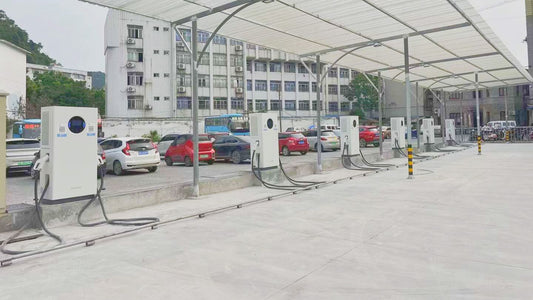AC charging and DC charging are two different methods for charging an electric vehicle (EV) battery.
AC charging, also known as Level 1 and Level 2 charging, uses alternating current (AC) power to charge an electric vehicle's battery. Level 1 charging uses a standard 120V AC household outlet and can take several hours to charge a battery, while Level 2 charging uses a higher-powered 240V AC circuit and can charge a battery faster, but still takes several hours. AC charging is convenient for overnight or workplace charging and is typically the most affordable type of charging available.
DC charging, also known as Level 3 or DC fast charging, uses direct current (DC) power to charge an electric vehicle's battery. DC fast charging can add up to 100 miles of range in just 30 minutes of charging, and is typically found at public charging locations, such as rest areas and highway service stations. DC fast charging is convenient for quickly charging a vehicle while on long road trips, but it can be more expensive to install and use compared to AC charging.
Both AC and DC charging have their benefits and drawbacks, and the best option for a particular electric vehicle owner will depend on their individual needs and charging habits. Some electric vehicle owners may prefer the convenience and affordability of AC charging, while others may require the fast-charging capabilities of DC charging for longer road trips.
Big difference between AC chargers and DC chargers

What is AC charging?
AC power electric vehicle charger, also known as Level 1 charging, is a type of electric vehicle (EV) charger that uses alternating current (AC) power to charge an electric vehicle's battery. It is a standard charging method that is designed for use at home or in a workplace and provides a slow charging rate.
Level 1 charging typically uses a standard 120V AC household outlet and can take several hours to charge an electric vehicle's battery, depending on the size of the battery and the charging rate of the vehicle. The charging rate is typically around 3-5 miles of range per hour of charging.
Level 1 charging is a convenient option for EV owners who want to charge their vehicle overnight or while at work, and it is typically the most affordable type of EV charger available.
Level 2 charging, also known as AC Level 2 charging, is a type of electric vehicle (EV) charger that uses alternating current (AC) power to charge an electric vehicle's battery. Unlike Level 1 charging, which uses a standard 120V AC household outlet, Level 2 charging uses a higher-powered 240V AC circuit, which allows for a faster charging rate.
Level 2 charging stations are typically installed in public places, such as shopping centers, parking garages, and workplaces, and can add up to 30 miles of range per hour of charging, depending on the size of the battery and the charging rate of the vehicle. Level 2 charging can take anywhere from 30 minutes to several hours to fully charge an electric vehicle, depending on the battery's capacity and the charging station's output.
Level 2 charging is a more convenient and faster option for electric vehicle owners who want to charge their vehicles while out and about, but it can be more expensive to purchase and install compared to Level 1 charging. Some Level 2 charging stations require a membership or a fee to use, while others may be available for free.
Pros of AC Charging:
Convenient: AC charging is convenient for overnight or workplace charging, as it can be done using a standard 120V AC household outlet or a higher-powered 240V AC circuit.
Affordable: AC charging is typically the most affordable type of charging available, as it does not require a specialized charging station or high-power electrical connection.
Safe: AC charging is a safe and reliable method for charging an electric vehicle, as it does not use high-power electrical connections and is less likely to pose a fire risk.
Cons of AC Charging:
Slow Charging: AC charging can take several hours to fully charge an electric vehicle, which may not be ideal for those who need to charge their vehicle quickly.
Limited Range: AC charging provides a slow charging rate, which can result in a limited amount of range added to the electric vehicle's battery during each charging session.
Limited Availability: AC charging is typically only available at home or in the workplace, which may not be convenient for those who need to charge their vehicle while on the go.
Overall, AC charging is a convenient and affordable option for electric vehicle owners who do not require fast charging capabilities, but it may not be the best choice for those who need to charge their vehicle quickly or while on the go.
What is DC charging?
DC fast charging, also known as Level 3 or DC Level 3 charging, is a type of electric vehicle (EV) charger that uses direct current (DC) power to charge an electric vehicle's battery. Unlike Level 1 and Level 2 charging, which use alternating current (AC) power and can take several hours to charge a battery, DC fast charging can add a significant amount of range in a relatively short amount of time.
DC fast charging stations use high-power DC electrical connections to charge an electric vehicle's battery, and can add up to 100 miles of range in just 30 minutes of charging. DC fast charging stations are typically found at public charging locations, such as rest areas, highway service stations, and shopping centers, and they can provide an easy and convenient way for electric vehicle owners to quickly charge their vehicles while on long road trips.
However, DC fast charging can be more expensive to install and use compared to Level 1 and Level 2 charging. In addition, not all electric vehicles are compatible with DC fast charging, and some vehicles may require the use of a specialized charging cable to connect to a DC fast charging station.
Pros of DC Fast Charging:
Fast Charging: DC fast charging can add up to 100 miles of range in just 30 minutes of charging, which is significantly faster than AC charging.
Convenient: DC fast charging is typically found at public charging locations, such as rest areas and highway service stations, which makes it convenient for electric vehicle owners who need to charge their vehicle while on long road trips.
Improved Range: With its fast charging capabilities, DC fast charging can greatly improve the range of an electric vehicle, making it more suitable for longer road trips.
Cons of DC Fast Charging:
Expensive: DC fast charging can be more expensive to install, and use compared to AC charging, both in terms of the cost of the charging station and the cost of the electricity used for charging.
Limited Availability: DC fast charging stations are not as widely available as AC charging options and may not be accessible in all areas.
Compatibility: Not all electric vehicles are compatible with DC fast charging, and some may require the use of a specialized charging cable.
Safety Concerns: DC fast charging uses high-power electrical connections, which can pose a fire risk if not properly installed and maintained.
Overall, DC fast charging provides fast charging capabilities and improved range for electric vehicle owners, but it can be more expensive and less widely available than AC charging. Additionally, safety and compatibility concerns may make it less suitable for some electric vehicle owners.




